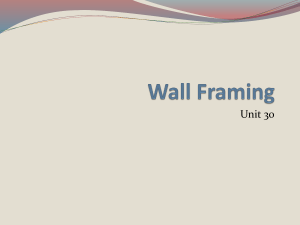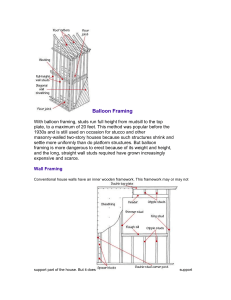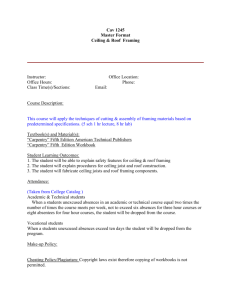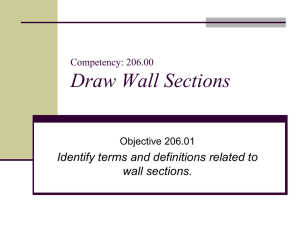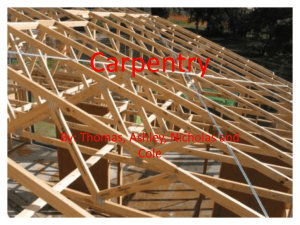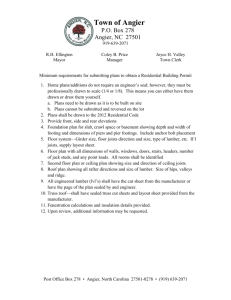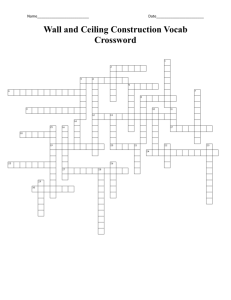Timber Framing
advertisement
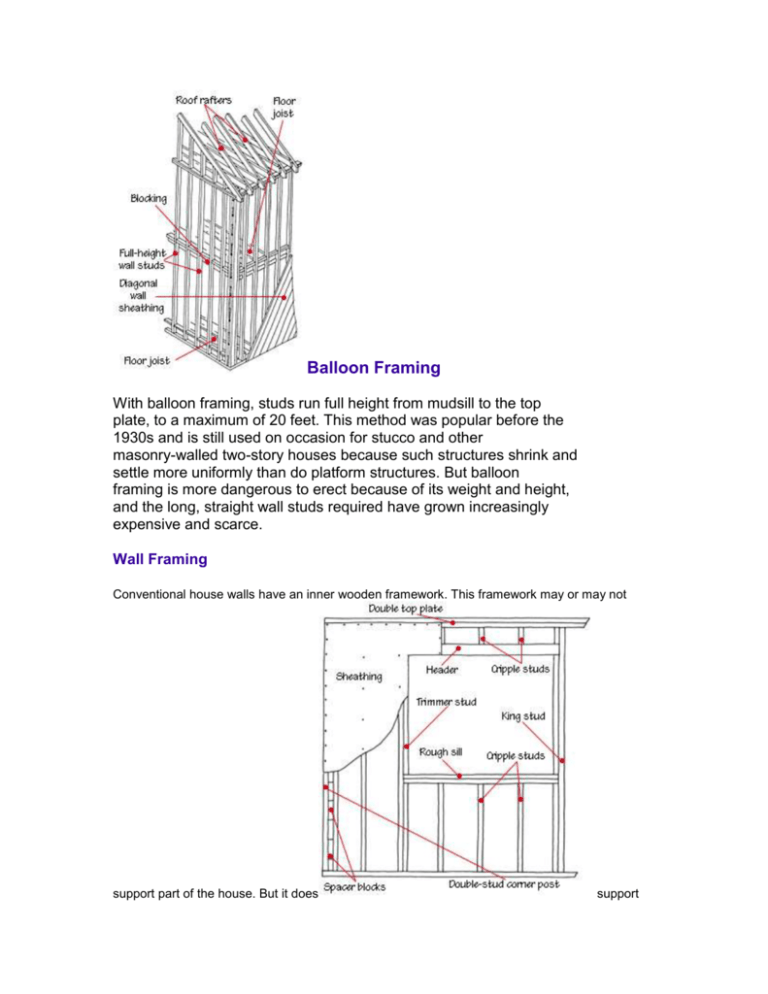
Balloon Framing With balloon framing, studs run full height from mudsill to the top plate, to a maximum of 20 feet. This method was popular before the 1930s and is still used on occasion for stucco and other masonry-walled two-story houses because such structures shrink and settle more uniformly than do platform structures. But balloon framing is more dangerous to erect because of its weight and height, and the long, straight wall studs required have grown increasingly expensive and scarce. Wall Framing Conventional house walls have an inner wooden framework. This framework may or may not support part of the house. But it does support wall coverings, windows and doors. And it provides cavities for electrical wiring, plumbing, heating ductwork, insulation and other utilities. Though most walls are framed with 2 by 4 wall studs, 2 by 6s are used to provide more strength and/or larger cavities for gear. Exterior walls, for example, may be framed with 2 by 6s to allow more room for insulation; some bathroom walls are framed with 2 by 6s to allow plenty of space for large pipes. And not all houses are framed with wooden wall studs. Some newer homes are built with metal studs, a practice adopted from commercial construction methods. Windows have a single or double sill across the base, made up of 2 by 4s laid flat. Trimmer studs support each end of a header and cripple studs fill in the areas above and below the openings. Cripple studs are placed on the 16- or 24-inch stud layouts. Wherever windows, doors or other openings occur along a wall, the regular studs are eliminated. Instead, a small beam, called a header, spans across the top of the opening, bridging the gap. A double top plate--two 2 by 4s or 2 by 6s laid flat-caps the top of the studs, locking studs in position, giving the wall rigidity and support and providing a backing for nailing-on wall covering materials. At the wall's base, studs are nailed to a 2 by 4 or 2 by 6 sole plate to lock them to the floor. Standard Wood Framing Most house built since the 1920s have wood-frame construction: a system of wooden wall studs, loor joists and other wooden members that provide structure and a framework for attaching finished surfaces. The high cost of lumber is fueling an interest in steel and other alternatives, but wood is still-far and away-the most popular framing material. In most cases, even houses that appear to have brick or stone walls actually have wood frame construction beneath their masonry façade. There are two basic framing methods: platform and balloon construction, as shown at right. Platform construction is much more common than balloon framing, though balloon framing was employed in many two-story houses before 1930. With both methods wall studs and ceiling and floor joists occur every 16 or 24 inches, measured from center to center. These standardized layouts take advantage of floor, ceiling and wall materials with the least cutting and waste. Most older houses have 2 by 4 wall studs spaced 16 inches on center; many newer houses have 2 by 6 wall studs either 16 or 24 inches on center to make exterior walls stronger and allow a larger cavity for wall insulation. Exterior wall sheathing adds rigidity to the structure and provides a flat base for siding, stucco or other exterior wall finish. Older homes have diagonal sheathing-1/2 inch-thick boards nailed on the diagonal. Most newer homes have plywood or similar composite panel sheathing. Exterior roof sheathing serves the same purposes for roofing. Most contemporary roof sheathing is either plywood or oriented-strand board (OSB) panels; spaced wood sheathing is common for wood shingle roofs. With platform construction, walls sit on top of subflooring. Multi-story houses are built one level at a time-each floor provides a platform for building the next series of walls. Nearly all contemporary houses are built using the platform construction method. Wall Framing The wall frame generally consists of 2 by 4 or 2 by 6 wall studs placed vertically every 16 or 24 inches, from center to center. Extra studs provide nailing area and sturdy support wherever walls intersect, such as at corners. Floor and Ceiling Framing Wherever an opening occurs, such as for a staircase, joists are doubled up at the perimeter and capped with perpendicular headers. Floor and Ceiling Framing Though some floors are built on a concrete slab-flat on the ground-most floors are raised above the ground. Raised floors are more resilient under foot and provide access for heating equipment, insulation, plumbing, wiring and other mechanical equipment. A raised floor is constructed with a wooden framework that bridges from one exterior wall to another. This framework may or may not be supported intermediately by girders, beams or walls. On upper levels of a house, the underside of the floor framing generally serves to back ceiling materials. Ceilings are usually built just like floors, only they may be constructed of lighter materials because they're not intended to carry the same loads. A floor's framework is made up mostly of wooden joists that run parallel to one another at regular intervals. Floor joists are typically 2 by 8s, 2 by 10s or 2 by 12s; ceiling joists are usually smaller-2 by 6s or even 2 by 4s in older homes. Some newer homes have manufactured, I-beam shaped joists. Floor joists, spaced on regular intervals, span the areas between supports such as walls, foundations, girders and beams. Normal spacing is 16 inches "on center" (from center to center), though some floors may have joists on 12-inch or 24-inch centers. Joist sizing and spacing are determined by building codes, which are based on engineering requirements. Joist headers run perpendicular to joists, capping their ends. At foundation level, floor joists rest directly on a sill that is treated with preservative so contact with the foundation will not encourage termites or rot. Exact construction and connection with wall studs depends upon the method of framing. Subflooring provides a base for finish flooring and also serves as a platform during construction. It may be made of boards laid either at right angles or diagonally across joists. Or the subfloor may be made of plywood or other panel products that are laid perpendicular to joists. Solid blocking or metal bridging prevents joists from twisting and helps distribute loads evenly. Joists are spliced over beams or other supports. They may be butted end-to-end and connected with plywood gusset plates or lapped. Roof Framing Driving through nearly any neighborhood, you can see that roofs have many different shapes. Houses have gable, hipped, mansard, gambrel, flat and shed roofs. And many homes combine varying roof types on one roof. It's quite common, for example to see a hipped roof with gable dormers. Roof shape is one of the key factors in setting the architectural style of a house. Roof shape also dictates how difficult and costly a roof is to build and how it will serve. For example, flat, shed and-in some case-gable roofs tend to be relatively affordable to build. Gambrel and mansard roofs offer more head height for attic rooms. Shed roofs are usually the easiest type to connect to an existing roof when adding-on. Roof framing can be simple or complex, depending on the roof. Overhangs, hips and dormers add greatly to the complexity of the framing. Here the major framing components are shown. Roof Framing Nearly all roofs are framed using one of two methods: standard stick framing or newer truss framing. Stick-framed roofs utilize individual rafters that span from the top of exterior walls to the ridge. Truss-framed roofs are built from triangular-shaped, pre-made truss units. Gable and hip roofs may be built primarily of trusses; other roof shapes, particularly those with dormers or on houses with cathedral ceilings, attic rooms or attic storage areas are stick built. Stick framing creates a triangle between rafters and ceiling joists. Collar beam adds strength at the middle. Like wall studs and floor joists, rafters and trusses are spaced every 16 or 24 inches from center to center. Most roofs utilize 16-inch spacings for strength and rigidity. Rafters are usually positioned directly above wall studs. A truss is one contiguous double rafter/ ceiling joist unit. Truss construction is just as strong but is lighter weight and uses smaller sizes of lumber than stick framing. Because trusses are carefully engineered units that shouldn't be cut, they are not a good choice for roofs that may be modified at a later date. And because they have several intermediate support members, they don't allow use of the attic space. The angle of a roof is measured and referred to by either slope or pitch. The slope of a roof is the number of inches a roof rises in 12 inches of horizontal run. A roof with a 5-in-12 slope rises 5 inches for every 12 inches of horizontal run. Pitch expresses the same two measurements as a fraction. The same roof has a 5/12 pitch.
